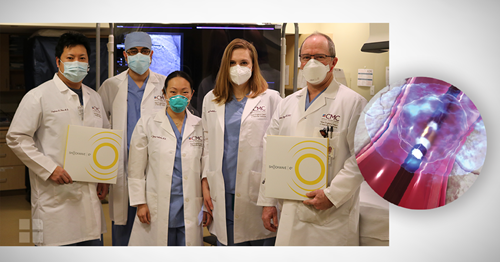Physicians have a number of tools to treat coronary artery disease, the most common type of heart disease in the United States. But one breakthrough technology being offered at Catholic Medical Center’s New England Heart & Vascular Institute (NEHVI) is being described as a “game changer.”

The Shockwave IVL (meaning intravascular lithotripsy) is a new approach to treating severe atherosclerosis— the buildup of calcified plaque in the arteries that causes CAD. Symptoms of CAD can include chest pain, weakness, shortness of breath, and heart attack.
Nearly a million patients a year undergo a stent procedure to open up the artery and restore blood flow to the heart. “You would usually use a balloon to push the calcium out of the way and place the stent,” says Stephan Heo, MD, FACC, an interventional cardiologist at NEHVI. Sometimes, however, the buildup is too severe for the balloon to expand the artery.
Historically, those more difficult cases were treated with a procedure called atherectomy, where a small drill is placed through a catheter into the artery to break up the calcified plaque. “It’s a higher risk procedure,” says Dr. Heo, “because of the possibility of perforation or the calcium breaking off and causing an obstruction further down the artery.”
The Shockwave IVL uses sound wave technology (lithotripsy) to fracture calcium at very low pressures, minimizing the risk of perforation. This allows the cardiologist to place the stent much more easily. “Think of it as a windshield,” says Dr. Heo. “Instead of shattering, the calcium cracks and stays together, but it can be moved more easily.”
The procedure is very similar to a standard stent placement. A balloon is placed through a catheter in the radial artery (the artery in the wrist). Once it reaches the blocked artery, the balloon is inflated to a low pressure. The Shockwave IVL system then deploys sonic pressure to fracture the calcified plaque. After that, the balloon inflates enough to allow the stent to be put in place. The blocked artery is opened up, allowing blood to flow and reducing the symptoms of CAD.
The idea of using sonic pressure isn’t new. In fact, lithotripsy has been used for decades to treat kidney stones. Applying it to CAD, however, “is an absolute game changer,” says Dr. Heo, “not only because of the increased safety but also the ability to get patients home.” In the past, patients who have atherectomy need to stay overnight in the hospital. Out of the dozens of Shockwave cases Dr. Heo has performed so far, almost everyone has gone home the same day.
Catholic Medical Center was one of the three hospitals in the country—and the first in New Hampshire—to start using the Shockwave IVL system which has since been adopted at facilities across the country. Dr. Heo has been presenting about it to physicians nationally who, he says, are excited about it. “This is breakthrough technology.”
As published in the Union Leader on August 15, 2021